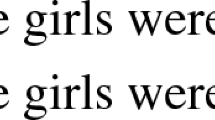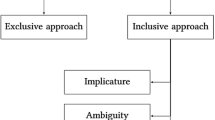Abstract
A number of natural language constructions seem to provide access to structured pluralities — that is, pluralities of pluralities. A body of semantic work has debated how to model this additional structure and the extent to which it depends on pragmatics. In this article, after controlling for the distinction between ambiguity and underspecification, we present new data showing that structured pluralities are sometimes but not always available, depending on the form of the plural noun phrase used. We show that these results challenge two longstanding theories of plurality. We sketch two different ways to account for these data and describe some of the diverging predictions they make.

Similar content being viewed by others
Notes
In Landman’s full system, a further ↑ operator would apply outside this structure, allowing the noun phrase to be the subject of the collective predicate.
Note that this test holds equally well for structural ambiguity and pronominal ambiguity (as in Schwarzschild’s analysis). In sentence (i), for example, the pronoun may have either Bill or John as an antecedent, but whichever it is, it must be the same individual on both Monday and Tuesday.
-
(i)
On Monday, Bill told John that he would win, but not on Tuesday.
-
(i)
Existential raising plays a less trivial role in cases with indefinites, where “min” does not return a singleton set, as in The students from two countries hit each other.
For a recent overview discussing other analyses of cumulativity, see Champollion (2020).
On the other hand, the analysis in §4.1 does not need to subscribe to other analytical assumptions of Winter (2000). Specifically, it is not committed to the availability of anaphoric dependencies everywhere — only to the fact that anaphoric dependencies may be generated by certain scope-taking operations.
Such a mechanism could potentially account for the rich variety of covers, sometimes visually presented, argued to be available by Schwarzschild (1996) — with the caveat that proper controls should be taken to ensure that these correspond to true readings of the sentences in question.
Bar-Lev (2019) argues that the ability to access such an underspecified reading varies across predicates, depending on the homogeneity of the predicate in question (i.e., whether the plural predication has the inference that all subpluralities behave identically with respect to the predicate). In our own results on symmetric readings, homogeneity plays no role, for two reasons: (i) all the predicates tested are homogeneous, and (ii) the target reading involves a collective predicate acting on a plurality of just two entities (themselves groups or pluralities), so there are no other proper parts of this plurality to which the predicate could apply.
References
Baayen, R. H., D. J. Davidson, and D. M. Bates. 2008. Mixed-effects modeling with crossed random effects for subjects and items. Journal of Memory and Language 59(4): 390–412. https://doi.org/10.1016/j.jml.2007.12.005.
Bar-Lev, M. E. 2019. Specification and homogeneity in plural predication. Unpublished manuscript, Institut Jean Nicod. https://semanticsarchive.net/Archive/WQ5ODgyY/.
Barr, D. J., R. Levy, C. Scheepers, and H. J. Tily. 2013. Random effects structure for confirmatory hypothesis testing: Keep it maximal. Journal of Memory and Language 68(3): 255–278. https://doi.org/10.1016/j.jml.2012.11.001.
Beck, S., and U. Sauerland. 2000. Cumulation is needed: A reply to Winter. Natural Language Semantics 8(4): 349–371. https://doi.org/10.1023/A:1011240827230.
Brasoveanu, A. 2008. Donkey pluralities: Plural information states versus non-atomic individuals. Linguistics and Philosophy 31(2): 129–209. https://doi.org/10.1007/s10988-008-9035-0.
Brasoveanu, A. 2013. Modified numerals as post-suppositions. Journal of Semantics 30(2): 155–209. https://doi.org/10.1093/jos/ffs003.
Champollion, L. 2016. Covert distributivity in algebraic semantics. Semantics and Pragmatics 9(15): 1–65. https://doi.org/10.3765/sp.9.15.
Champollion, L. 2017. Parts of a Whole: Distributivity as a Bridge Between Aspect and Measurement. New York: Oxford University Press. https://doi.org/10.1093/oso/9780198755128.001.0001.
Champollion, L. 2020. Distributivity, collectivity, and cumulativity. In The Wiley Blackwell Companion to Semantics, eds. D. Gutzmann, L. Matthewson, C. Meier, H. Rullmann, and T. E. Zimmermann. Hoboken: Wiley. https://doi.org/10.1002/9781118788516.sem021.
Dalrymple, M., M. Kanazawa, Y. Kim, S. McHombo, and S. Peters. 1998. Reciprocal expressions and the concept of reciprocity. Linguistics and Philosophy 21(2): 159–210. https://doi.org/10.1023/A:1005330227480.
Dotlačil, J. 2013. Reciprocals distribute over information states. Journal of Semantics 30(4): 423–477. https://doi.org/10.1093/jos/ffs016.
Florio, S., and D. Nicolas. 2015. Plural logic and sensitivity to order. Australasian Journal of Philosophy 93(3): 444–464. https://doi.org/10.1080/00048402.2014.963133.
Florio, S., and D. Nicolas. 2020. Plurals and mereology. Journal of Philosophical Logic. https://doi.org/10.1007/s10992-020-09570-9.
Gillon, B. S. 1984. The logical form of plurality and quantification in natural language. Ph.D. thesis, MIT, Cambridge, MA. https://dspace.mit.edu/handle/1721.1/15442.
Gillon, B. S. 1987. The readings of plural noun phrases in English. Linguistics and Philosophy 10(2): 199–219. https://doi.org/10.1007/BF00584318.
Gillon, B. S. 1990a. Ambiguity, generality, and indeterminacy: Tests and definitions. Synthese 85(3): 391–416. https://doi.org/10.1007/BF00484835.
Gillon, B. S. 1990b. Plural noun phrases and their readings: A reply to Lasersohn. Linguistics and Philosophy 13: 477–485. https://doi.org/10.1007/BF00630751.
Gillon, B. S. 1992. Towards a common semantics for English count and mass nouns. Linguistics and Philosophy 15: 597–639. https://doi.org/10.1007/BF00628112.
Gillon, B. S. 2004. Ambiguity, indeterminacy, deixis, and vagueness: Evidence and theory. In Semantics: A Reader, eds. S. Davis and B. S. Gillon, 157–190. New York: Oxford University Press.
Grimau, B. 2019. In defence of Higher-Level Plural Logic: Drawing conclusions from natural language. Synthese. https://doi.org/10.1007/s11229-019-02399-z.
Grimau, B. 2020. Structured plurality reconsidered. Journal of Semantics 38(1): 145–193. https://doi.org/10.1093/jos/ffaa012.
Haug, D. T. T., and M. Dalrymple. 2020. Reciprocity: Anaphora, scope, and quantification. Semantics and Pragmatics 13(10). https://doi.org/10.3765/sp.13.10.
Henderson, R. 2014. Dependent indefinites and their post-suppositions. Semantics and Pragmatics 7(6): 1–58. https://doi.org/10.3765/sp.7.6.
Kobele, G. M. 2010. Inverse linking via function composition. Natural Language Semantics 18(2): 183–196. https://doi.org/10.1007/s11050-009-9053-7.
Kuhn, J. 2017. Dependent indefinites: The view from sign language. Journal of Semantics 34(3): 407–446. https://doi.org/10.1093/jos/ffx007.
Landman, F. 1989. Groups, I. Linguistics and Philosophy 12(5): 559–605. https://doi.org/10.1007/BF00627774.
Landman, F. 2020. Iceberg Semantics for Mass Nouns and Count Nouns: A New Framework for Boolean Semantics, Cham: Springer Nature. https://doi.org/10.1007/978-3-030-42711-5.
Lasersohn, P. 1989. On the readings of plural noun phrases. Linguistic Inquiry 20(1): 130–134. https://www.jstor.org/stable/4178619.
Link, G. 1983. The logical analysis of plurals and mass terms: A lattice-theoretical approach. In Meaning, Use, and Interpretation of Language, eds. R. Bäuerle, C. Schwarze, and A. von Stechow, 303–323. Berlin: de Gruyter. https://doi.org/10.1515/9783110852820.302.
Link, G. 1984. Hydras: On the logic of relative constructions with multiple heads. In Varieties of Formal Semantics: Proceedings of the Fourth Amsterdam Colloquium, eds. F. Landman and F. Veltman, 245–257. Dordrecht: Foris.
Link, G. 1998. Algebraic Semantics in Language and Philosophy. Stanford: CSLI Publications.
Linnebo, Ø., and D. Nicolas. 2008. Superplurals in English. Analysis 68(3): 186–197. https://doi.org/10.1093/analys/68.3.186.
Marty, P., E. Chemla, and J. Sprouse. 2020. The effect of three basic task features on the sensitivity of acceptability judgment tasks. Glossa 5(1): 1–23. https://doi.org/10.5334/gjgl.980.
May, R., and A. Bale. 2006. Inverse linking. In The Wiley Blackwell Companion to Syntax, eds. M. Everaert and H. van Riemsdijk, 639–667. Malden: Wiley. https://doi.org/10.1002/9780470996591.ch36.
McKay, T. J. 2006. Plural Predication. New York: Oxford University Press. https://doi.org/10.1093/acprof:oso/9780199278145.001.0001.
Nouwen, R. 2003. Plural pronominal anaphora in context: Dynamic aspects of quantification. Ph.D. thesis, Utrecht University. https://hdl.handle.net/1874/630.
Oliver, A., and T. Smiley. 2004. Multigrade predicates. Mind 113(452): 609–681. https://doi.org/10.1093/mind/113.452.609.
Partee, B., and M. Rooth. 1983. Generalized conjunction and type ambiguity. In Meaning, Use, and Interpretation of Language, eds. R. Bäuerle, C. Schwarze, and A. von Stechow, 361–383. Berlin: de Gruyter. https://doi.org/10.1515/9783110852820.361.
Poortman, E. B., M. E. Struiksma, N. Kerem, N. Friedmann, and Y. Winter. 2018. Reciprocal expressions and the Maximal Typicality Hypothesis. Glossa 3(1): 1–30. https://doi.org/10.5334/gjgl.180.
Sabato, S., and Y. Winter. 2012. Relational domains and the interpretation of reciprocals. Linguistics and Philosophy 25(3): 191–241. https://doi.org/10.1007/s10988-012-9117-x.
Schütze, C. T., and J. Sprouse. 2013. Judgment data. In Research Methods in Linguistics, eds. R. J. Podesva and D. Sharma, 27–50. Cambridge: Cambridge University Press.
Schwarzschild, R. 1996. Pluralities. Dordrecht: Kluwer Academic.
van den Berg, M. H. 1996. Some aspects of the internal structure of discourse: The dynamics of nominal anaphora. Ph.D. thesis, University of Amsterdam. https://hdl.handle.net/11245/1.111452.
Winter, Y. 2000. Distributivity and dependency. Natural Language Semantics 8(1): 27–69. https://doi.org/10.1023/A:1008313715103.
Winter, Y. 2001. Flexibility Principles in Boolean Semantics: the Interpretation of Coordination, Plurality, and Scope in Natural Language. Cambridge: MIT Press.
Winter, Y., and R. Scha. 2015. Plurals. In Handbook of Contemporary Semantic Theory, 2nd ed., eds. S. Lappin and C. Fox, 77–113. Malden: Wiley. https://doi.org/10.1002/9781118882139.ch3.
Wohlmuth, K. 2018. Nonatomic distributive readings: An experimental perspective. In Conference of the Student Organization of Linguistics in Europe (ConSOLE), Vol. 26, 139–156. https://www.universiteitleiden.nl/binaries/content/assets/geesteswetenschappen/lucl/sole/console-xxvi.pdf.
Wurmbrand, S. 2018. The cost of raising quantifiers. Glossa 3(1): 1–40. https://doi.org/10.5334/gjgl.329.
Author information
Authors and Affiliations
Corresponding author
Additional information
Publisher’s Note
Springer Nature remains neutral with regard to jurisdictional claims in published maps and institutional affiliations.
Authors are listed in alphabetical order. This work benefited from discussion at the Workshop on Cross-Linguistic Semantics of Reciprocals in Utrecht. We would like to thank in particular Denis Paperno, Filipe Hisao Kobayashi, and Louise McNally, as well as our anonymous referees. The research leading to these results received support from ERC FP7 grant 313610 (SemExp), ERC H2020 grant 788077 (Orisem), and ANR-17-EURE-0017 (FrontCog).
Rights and permissions
About this article
Cite this article
Buccola, B., Kuhn, J. & Nicolas, D. Groups versus covers revisited: Structured pluralities and symmetric readings. Nat Lang Semantics 29, 509–525 (2021). https://doi.org/10.1007/s11050-021-09179-x
Accepted:
Published:
Issue Date:
DOI: https://doi.org/10.1007/s11050-021-09179-x




